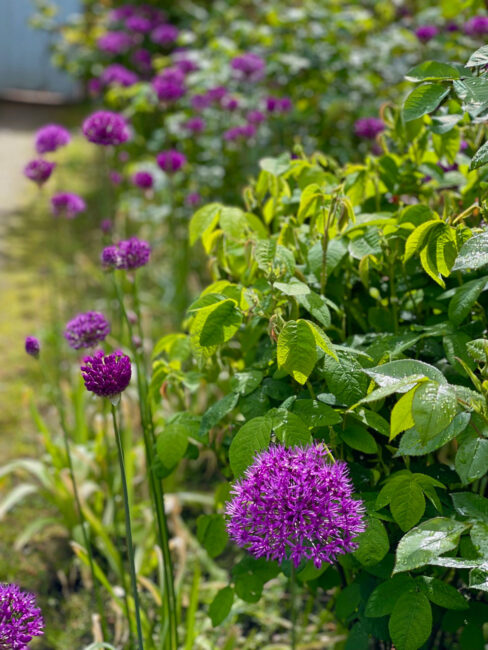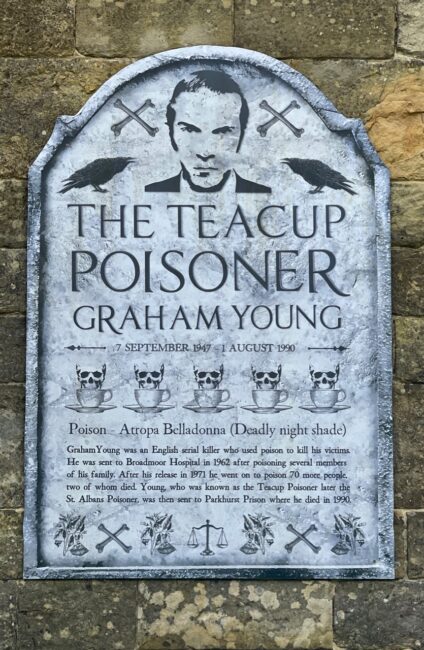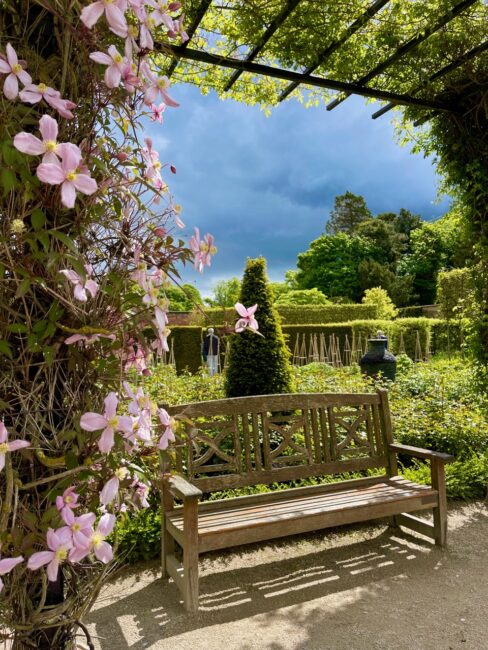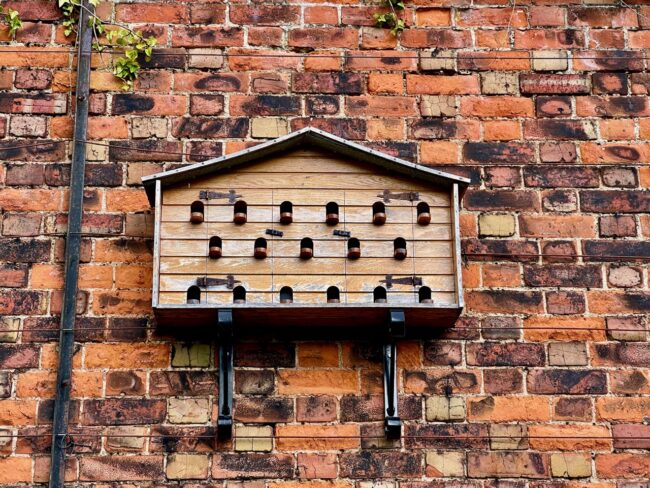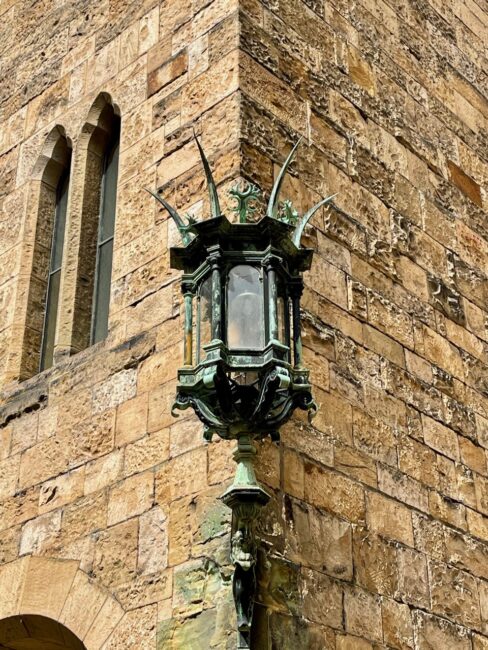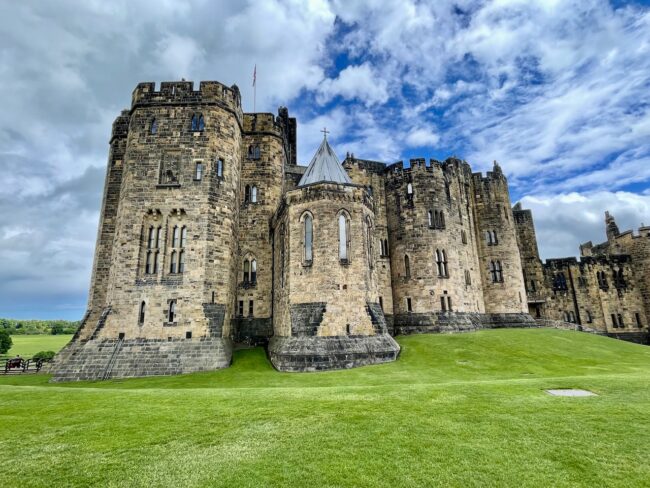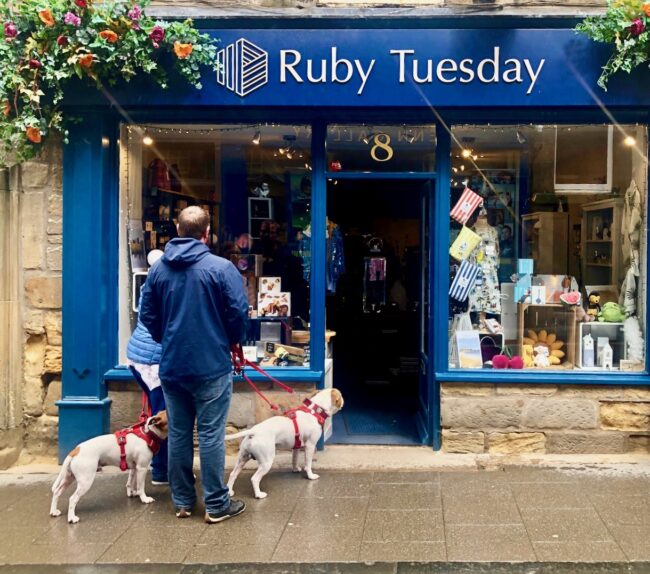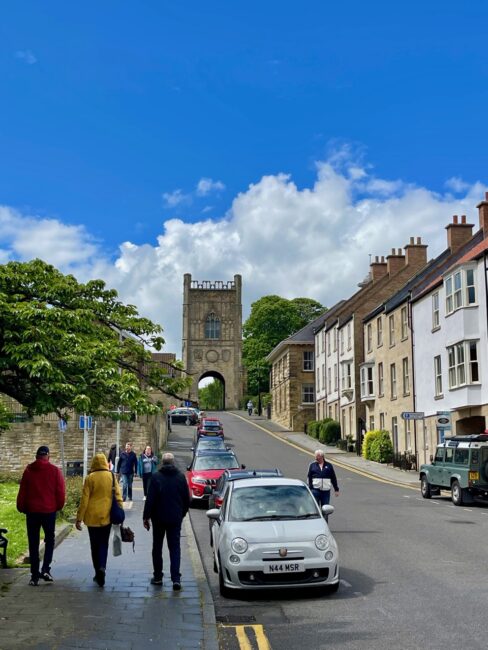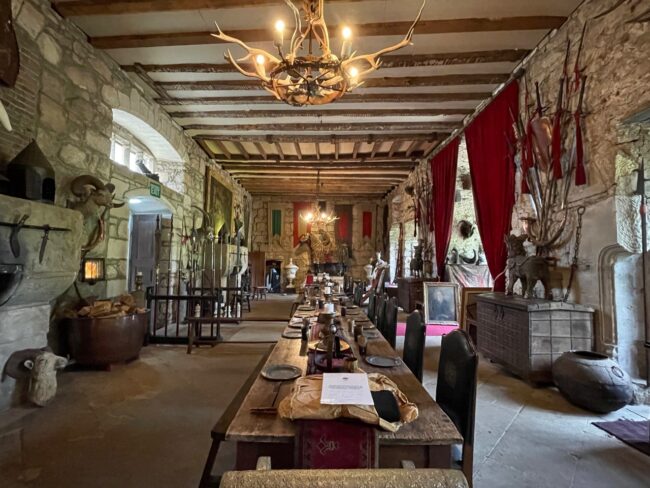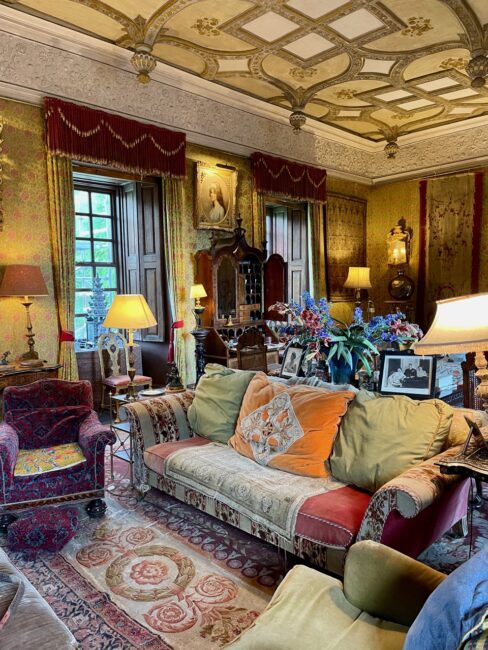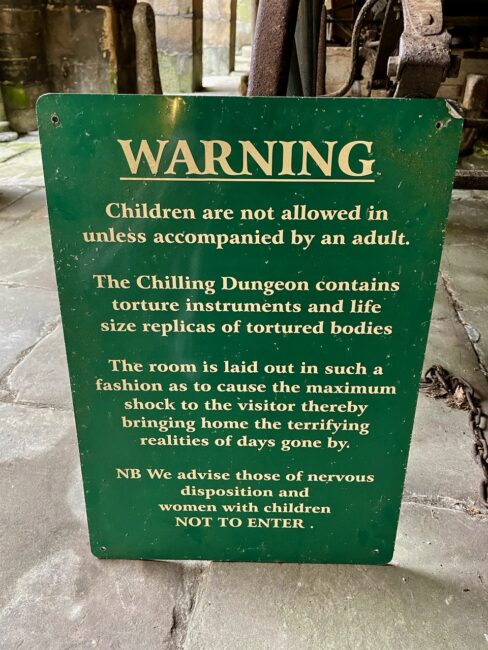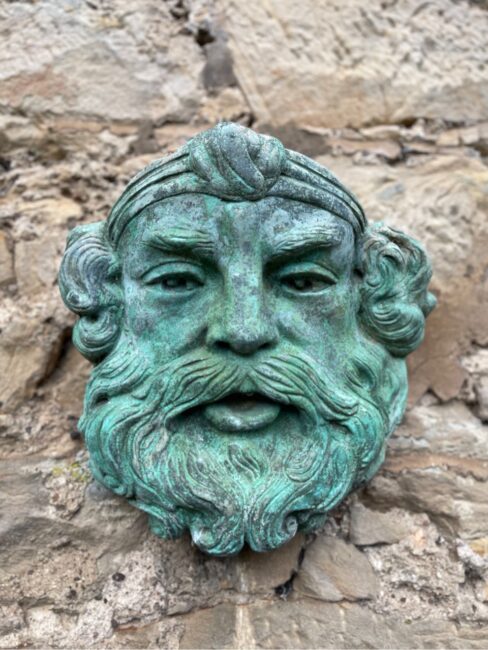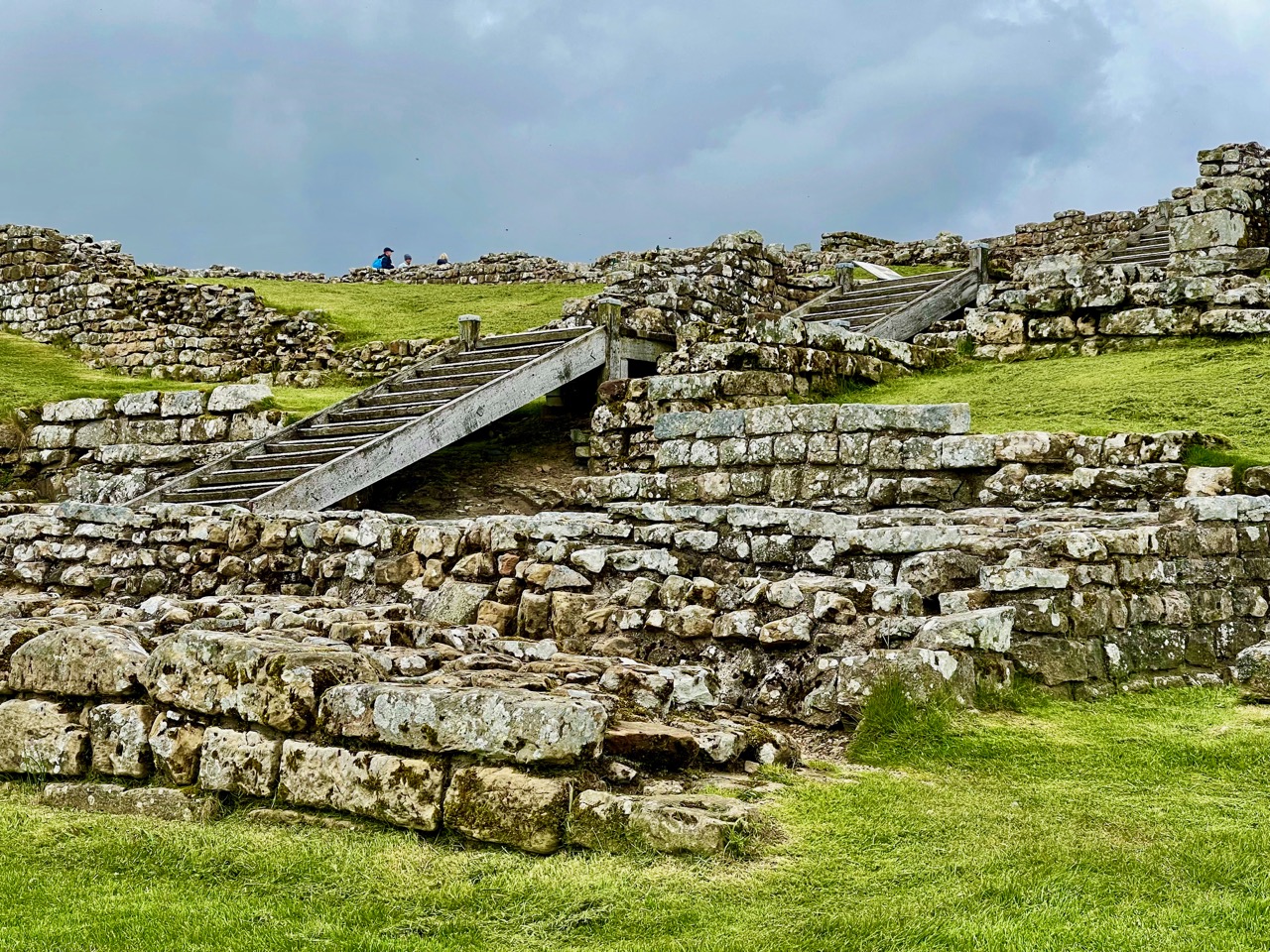
CHAPTER NINE: Enjoying The Northumberland Countryside
July 26, 2022
CHAPTER ELEVEN: Bamburgh Castle & Holy Island
August 6, 2022Surviving Mai Tai Tom’s “Royal” Blunder: 2022 England & Scotland
CHAPTER TEN: Trying Not To Get Poisoned In Alnwick
Day Ten: Parking Problems, Please Don’t Eat The Plants, “I Didn’t Know Gardening Was So Dangerous”, Blooming Too Soon, Not Blooming Soon Enough, Why Is My Tongue Blue?, 700 Years Of History, Hey Hotspur, “Deeply Eccentric Castle”, Castle Hoarders, Rack ‘Em Up, More Butter Cookies and Swan Diving
After a delicious English breakfast at our 19th-century Georgian country house B&B Budle Hall, it was a short 20-minute drive to Alnwick where we had 10 a.m. reservations at The Alnwick Garden. Unfortunately, it took us about 20 more minutes to find a place to park since our GPS and crack navigators had us going in circles. Then, we mistakenly walked to the entrance of Alnwick Castle, where we did have tickets for later in the day so the guard sent us on a wild goose chase though town trying to find the gardens. This group needed more coffee. Finally entering the 45-acre Alnwick Garden, we spied the Grand Cascade that has been here since the gardens opened in 2001.
Soon we found the gate leading to The Poison Garden where we learned there was an 11 o’clock tour. Since we were so late, we could wait 20-minutes for it.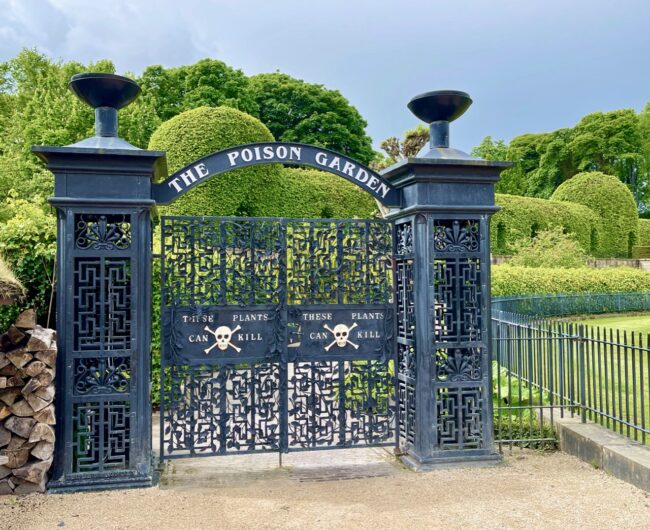
At the recommendation of the Poison Tour guy, for the next 15 minutes, we checked out the Cherry Blossom Orchard. Alnwick has the largest collection of Taihaku Cherry Blossoms in the world (329).
Sadly, they had bloomed in the two weeks prior to our visit (due to the late spring, our floral timing was just a tad off in many places we visited).
Fortunately, the flowers underneath the trees were floriferous (Tracy’s word, not mine, I had to look it up).
We were back in line for the 11 o’clock tour (20 people maximum) of The Poison Garden. Our guide, Dean, was a crack-up reminding us of the guides who used to tell jokes on The Jungle Cruise at Disneyland.
We learned that Castor is the most poisonous plant in the world. It seems Ricin is the poison found in castor beans. I was going to ask Dean if that would make it a dish of ricin beans, but I felt it better to let him tell all the jokes. With a straight face, he told us that in Madeira, it is a wedding tradition to give the bride four castor beans in case the marriage doesn’t work out.
Then he showed us the plaque about “The Umbrella Murder,” where a member of the Bulgarian Secret Service was assassinated by someone by firing a pellet of ricin from his umbrella. Now that’s a case of a lethal Bumbershoot.
There were plaques posted about of murderers in The Poison Garden who used deadly substances in their dastardly deeds.
Dean showed us a number of poisonous plants that could be growing in your backyard. He said that a laurel hedge contains cyanide gas. One of the tourists commented, “I didn’t know gardening was so dangerous.” Dean added that 90% of plants purchased in your local garden center are poisonous in some way.
Cannabis is illegal in the UK, but they have a license to grow it in the cage, which provided the last pun of the tour.
After the tour, we hiked up past the Grand Cascade.
At the top, we stopped by the Ornamental Garden.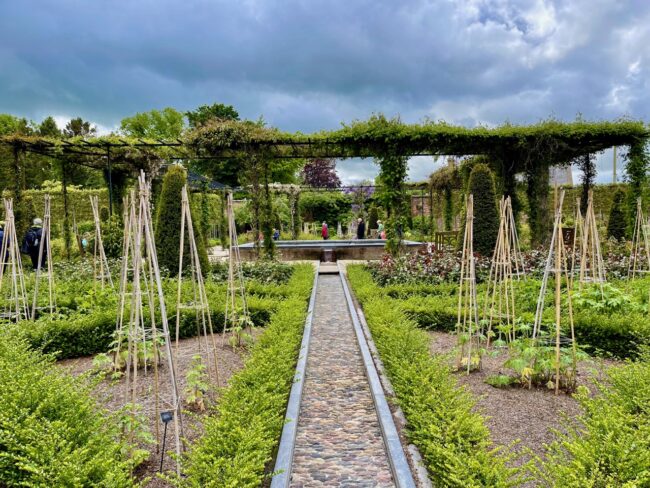
It contains 16,500 plants, so we figured something must be blooming. And we were right.
The peonies were just starting, as well as the irises, lupines, …
… tulips and other flowers. The roses were not yet in bloom.
This makes for a birds-eye perch for the garden’s feathered friends.
We purchased a book about the people who use poison as their method of murder. I better watch my back. Of course, the clotted cream would probably kill me first.
On the walk to the castle there was a gelato stand donating the proceeds from the sale of the blue banana milkshake gelato to Ukraine. I don’t know if that’s true, but their Ukrainian flag gelato will make your tongue blue for hours.
Our next stop was Alnwick Castle, which has been the home of the Percy family for more than 700 years and is the second largest inhabited castle in the UK. It’s a pretty stroll from the garden.
The downside of having a family in residence is that no interior photographs are allowed. 
The castle has been used in Harry Potter, Downton Abbey and other TV shows and films.
The castle is well maintained and has a treasure trove of artifacts in virtually ever room of the house. I guess after living in a castle for 700 years, you collect some cool stuff like paintings by such artists as Gainsborough, Canaletto, Titian and Tintoretto.
It was a good sky on this day with interesting cloud formations. There were spectacular views out onto the pastoral countryside from the castle.
It couldn’t quite decide if it wanted to clear up or start raining.
The castle has undertaken many restoration projects throughout the centuries, and the rooms have been remodeled several times over.
Before leaving the grounds we noticed a coach, and it was not Ted Lasso. This was the State Coach of the Duke of Northumberland from around the mid-1820s. It carried the 3rd Duke of Northumberland as King George IV’s personal representative at the coronation of Charles X in France.
We also saw a statue for Sir Henry Percy also known as the famous Harry Hotspur later in life. Henry was born at Alnwick Castle in 1364, and was knighted by the age of 12 and saw his first military service at the Siege of Berwick at age 14.
Because he was always ready to advance and attack against the Scots, they nicknamed him ‘Hatspore.’ He led quite a life, albeit a short one. Having turned against Henry IV, at the battle in Shrewsbury, he died at the age of 39, when he was killed by an arrow that pierced his face. He is buried at York Minster.
A quick lunch in Alnwick, then we bid goodbye to Ruby Tuesday, a store we walked by as we headed toward Pottergate Tower, which was near where we parked our car.
There was yet one more statue of Harry Hotspur to check out before leaving town.
We had planned on going to Dunstanburgh Castle, but all the reports said it would rain fairly hard, and it’s quite a hike out to the castle from the parking lot, so we recalled what our host Celia at Budle Hall had recommended. She told us, “You should really go see Chillingham Castle. It is deeply eccentric … and haunted.” Our curiosity piqued, we set off for Chillingham Castle. “Eccentric” only touched the surface of this castle.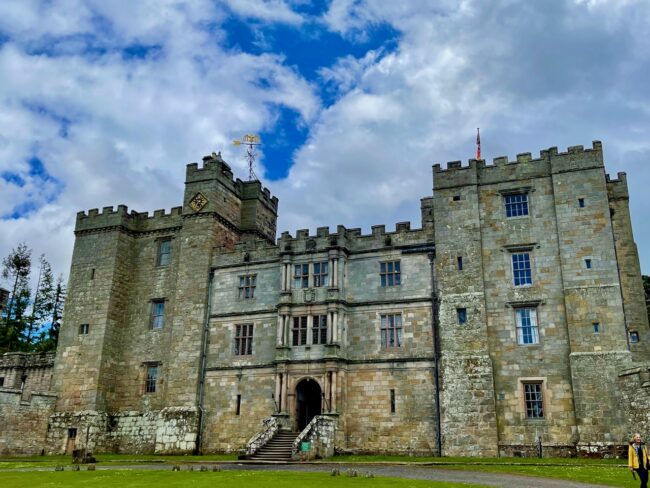
Set in a forest-like setting, we walked to the 12th-century castle from the parking area. This medieval castle looks pretty much like it did back then. It also has quite a history. This is where Charles I spent three nights before he was captured and finally executed outside the Banqueting House in London. Apparently, the castle was in disrepair and vacant for centuries before the current occupant moved in and started his collection of stuff … I mean antiquities.
Walking up to the entrance, it did feel like the place was haunted. It bills itself as “Britain’s Most Haunted Historic Castle.” We wondered whether we had a ghost of a chance surviving our self-guided tour. I gazed up at the bat weather vane before crossing myself (and I’m not Catholic) and entering.
Once inside we were in The Great Hall, which has an array of armor, tapestries and antlers.
It was constructed for the royal visit of Scotland’s James VI.
There were also visits by other royals. I don’t think this was one.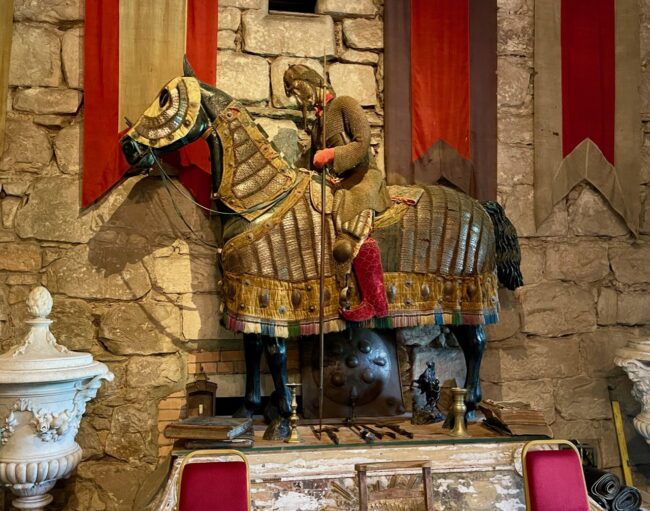
Above the mantle is an elephant made of, well we don’t know what. Parts of the castle did look like the owners visited a swap meet.
Other rooms we visited (not in order) were the King Edward Room, which is the most ancient state room. “The room is named after the visit of “Proud Edward, Hammer of the Scots” in 1298, on his way to the battle of Falkirk where he captured William Wallace (Brave Heart), who had ‘visited’ the previous year, burning women and children in a local church.’” Once again I wished I’d studied history in the UK.
Someone needs to straighten up this bedroom.
From The Roof Garden Lookout you can see the layout of the garden.
Signs everywhere warn you to tread carefully as you walk through the castle and the stairs. I always “tread carefully” on stairs these days. I am fairly certain this is the King James I Room, named after the king who visited in 1603. This was one of the nicer rooms in the castle.
I am fairly certain this is the King James I Room, named after the king who visited in 1603. This was one of the nicer rooms in the castle.
We stepped into The Plaque Room Library, which contains family memorabilia. “The fine carved stone chimney piece is surmounted by an intricate 16th century plasterwork armorial plaque.”
There’s also a cow up on the wall, and it is said to be “a long-time friend to the Castle and a cousin of the Chillingham Wild Cattle.” No one had the guts to say that might be udder nonsense.
Next was The New Dining Room, which gave us food for thought.
There was stuff everywhere, and at times we felt we were in an episode of the Hoarders TV show, but then again, maybe Antiques Road Show would know what to do with all the stuff. The family was obviously into things that fly.
The Chapel has been restored. As the literature states, “At one time, it was a library, and the ghost writer, Lady Tankerville, found it hard to accept that she could not find spirits here as two “grinning skeletons” had been found below the floor boards (the bones of which are now in the ‘Ossuary’). She was not to know that they were happily at rest in their chapel!”
These are said to be Antlers of an Irish Elk that might date back 10,000 or more years.
We don’t know how old these guys are.
Finally, we hit the Torture Chamber. Means of torture were seen throughout the room.
And, as the sign warned, we did see “life size replicas of tortured bodies.”
The bodies did seem to be racking up.
Outside, we quickly checked out the walled garden we had seen from the roof.
We wandered for a bit in there.
This castle actually turned out to be a good stop, and quite different from other castles, although I can’t say it was a haunting experience, but then again we weren’t there for the night tour.
I’m glad we took a shot visiting here.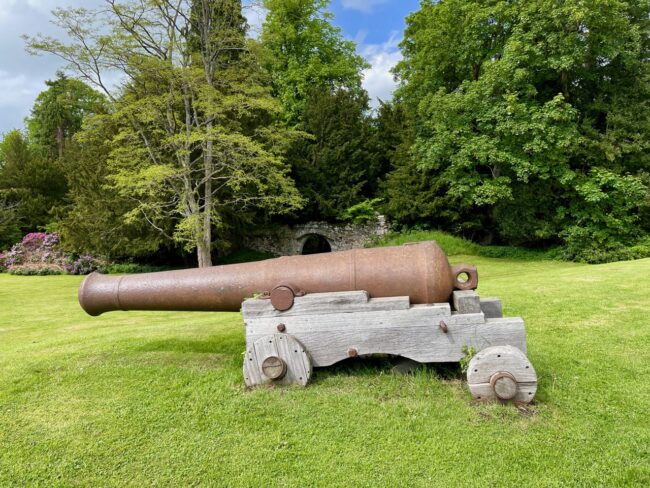
Oh, and those rhododendrons were everywhere.
The weather certainly was threatening on the way back to Budle Hall, with the rumbling of dark clouds and rain.
 However, by the time we arrived everything was peaceful looking out our bedroom window.
However, by the time we arrived everything was peaceful looking out our bedroom window.
Again we had tea in the drawing room, with the highlight once again being those addictive shortbread cookies. We had an inkling they were homemade.
Dinner was in nearby Warenford at the cozy White Swan Inn.
At the recommendation of our hosts who said the chef was “brilliant” we had another fantastic meal (described here).
Tomorrow would be an eventful day (I guess they all are).
 We’d visit another fascinating residence that belonged to Lord Armstrong, an interesting Bamburgh church, have lunch on the water and then try not to submerge our automobile by visiting an island with a famous castle and a gorgeous abbey.
We’d visit another fascinating residence that belonged to Lord Armstrong, an interesting Bamburgh church, have lunch on the water and then try not to submerge our automobile by visiting an island with a famous castle and a gorgeous abbey.
CHAPTER ELEVEN: Bamburgh Castle & A Visit To Holy Island
Next: What The “H”, Another Visit With Lord Armstrong, Gunpowder, Kim & Mary Skip A Church, Saying Grace, Lean On Me, Waterfront Lunch, Low Tide, Dog Day Afternoon, Pick Up The Poop, Castle High, Against The Wind, A Priory Commitment, Could We Have That Recipe? and Getting Potted




